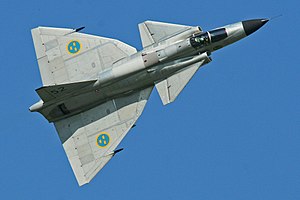Saab 37 Viggen
| AJ/JA 37 Viggen | |
|---|---|
 |
|
| Swedish Air Force Historic Flight AJ 37 in 2013 | |
| Role | Attack, fighter, reconnaissance |
| National origin | Sweden |
| Manufacturer | Saab AB |
| First flight | 8 February 1967 |
| Introduction | 21 June 1971 |
| Retired | 25 November 2005 |
| Primary user | Swedish Air Force |
| Produced | 1970–90 |
| Number built | 329 |
| Unit cost |
$2,000,000 (1967)
|
|
|
|
|
|
|
|
|
The Saab 37 Viggen ("Thunderbolt", also "Tufted duck") is a Swedish single-seat, single-engine, short-medium range combat aircraft. Development work on the type was initiated at Saab in 1952 and, following the selection of a radical delta wing configuration, the resulting aircraft performed its first flight on 8 February 1967 and entered service in 21 June 1971. The Viggen holds the distinction of being the first canard design to be produced in quantity.
Several distinctive variants of the Viggen were produced to perform the roles of strike fighter (AJ 37), aerial reconnaissance (SF 37), maritime patrol aircraft (SH 37) and a two-seat trainer (SK 37). In the late 1970s, the all-weather fighter-interceptor aircraft JA 37 variant was introduced. In November 2005, the Viggen was retired from service by the Swedish Air Force, the sole operator of the type, having been replaced by the newer Saab JAS 39 Gripen.
The Viggen was initially developed as an intended replacement for the Saab 32 Lansen in the attack role and later the Saab 35 Draken as a fighter. In 1955, as Saab's prototype Draken, the most aerodynamically advanced fighter in the world at that point, performed its first flight, the Swedish Air Force was already forming a series of requirements for the next generation of combat aircraft; due to the challenging nature of these requirements, a lengthy development time was anticipated, with the first flight intended to be no early than the middle of the next decade. Between 1952 and 1957, the first studies towards what would become the Viggen were carried out, involving the Finnish aircraft designer Aarne Lakomaa. Over 100 different concepts were examined in these studies, involving both single- and twin engine configurations, both traditional and double delta wings, and canard wings. Even VTOL designs were considered, with separate lift engines, but were soon identified as being unacceptable.
...
Wikipedia
